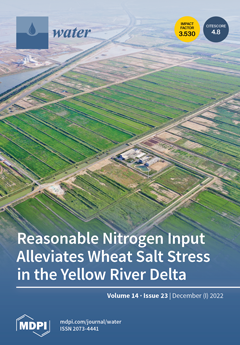This study assessed the spatiotemporal variability and pollution grades of heavy metals in water and sediments of Bahr El-Baqar drain, Eastern Nile Delta, Egypt, by integration of geochemical analysis, metal pollution indices, correlation, and multivariate statistical analyses. Twenty samples of water and sediments
[...] Read more.
This study assessed the spatiotemporal variability and pollution grades of heavy metals in water and sediments of Bahr El-Baqar drain, Eastern Nile Delta, Egypt, by integration of geochemical analysis, metal pollution indices, correlation, and multivariate statistical analyses. Twenty samples of water and sediments were collected during 2018 and analyzed for heavy metal concentrations using ICP-OES. Heavy metal contents in the water samples followed the order: Fe > Zn > Al > Pb > Mn > Cu > Ni. The drain sediments were highly contaminated with heavy metals that followed the order: Fe > Al > Mn > V > Zn > Cu > Cr > Ba > Ni > Pb > As. Spatiotemporally, most metals in the drain sediments showed a decreasing trend from upstream (south) to downstream sites (north). Results of principal component analysis (PCA) supported those from the Pearson correlation between investigated heavy metals. In water, Mn, Ni, Pb, Zn, Cu, and Fe showed highly significant correlations. In sediments, Ba, Ni, Zn, Fe, Al, Mn, and V showed strong positive correlations indicating that these metals were derived from similar anthropogenic sources. The calculated metal pollution indices: enrichment factor (EF), contamination factor (CF), pollution load index (PLI), degree of contamination (DC), and index of geo-accumulation (I
geo) indicated high loadings of heavy metals in the drain sediments. EFs revealed low, moderate to significant enrichment, whereas CFs showed low, moderate, and considerable contamination. PLI indicated low, baseline, and progressive contamination, while DC indicated low, moderate, and considerable degree of contamination. I
geo of all investigated metals (except for As; class 1) indicated extremely contaminated sediments (class 7).
Full article





